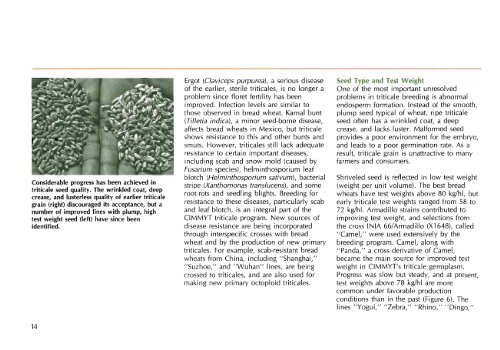U - Search CIMMYT repository
U - Search CIMMYT repository
U - Search CIMMYT repository
You also want an ePaper? Increase the reach of your titles
YUMPU automatically turns print PDFs into web optimized ePapers that Google loves.
Considerable progress has been achieved in<br />
triticale seed quality. The wrinkled coat, deep<br />
crease, and lusterless quality of earlier triticale<br />
grain (right) discouraged its acceptance, but a<br />
number of improved lines with plump, high<br />
test weight seed (left) have since been<br />
identified.<br />
Ergot (C1aviceps purpurea), a serious disease<br />
of the earlier, sterile triticales, is no longer a<br />
problem since floret fertility has been<br />
improved. Infection levels are similar to<br />
those observed in bread wheat. Kamal bunt<br />
(Til/etia indica), a minor seed-borne disease,<br />
affects bread wheats in Mexico, but triticale<br />
shows resistance to this and other bunts and<br />
smuts. However, triticales still lack adequate<br />
resistance to certain important diseases,<br />
including scab and snow mold (caused by<br />
Fusarium species), helminthosporium leaf<br />
blotch (He/minthosporium sativum), baderial<br />
stripe (Xanthomonas trans/ucens), and some<br />
root-rots and seedling blights. Breeding for<br />
resistance to these diseases, particularly scab<br />
and leaf blotch, is an integral part of the<br />
C1MMYT triticale program. New sources of<br />
disease resistance are being incorporated<br />
through interspecific crosses with bread<br />
wheat and by the produdion of new primary<br />
triticales. For example, scab-resistant bread<br />
wheats from China, including "Shanghai,"<br />
"Suzhoe," and "Wuhan" lines, are being<br />
crossed to triticales, and are also used for<br />
making new primary octoploid triticales.<br />
Seed Type and Test Weight<br />
One of the most important unresolved<br />
problems in triticale breeding is abnormal<br />
endosperm formation. Instead of the smooth,<br />
plump seed typical of wheat, ripe triticale<br />
seed often has a wrinkled coat, a deep<br />
crease, and lacks luster. Malformed seed<br />
provides a poor environment for the embryo,<br />
and leads to a poor germination rate. As a<br />
result, triticale grain is unattradive to many<br />
farmers and consumers.<br />
Shriveled seed is reflected in low test weight<br />
(weight per unit volume). The best bread<br />
wheats have test weights above 80 kg/hl, but<br />
early triticale test weights ranged from 58 to<br />
72 kg/hI. Armadillo strains contributed to<br />
improving test weight, and selections from<br />
the cross INIA 66/Armadillo (X1648), called<br />
"Camel," were used extensively by the<br />
breeding program. Camel, along with<br />
"Panda," a cross derivative of Camel,<br />
became the main source for improved test<br />
weight in C1MMYT's triticale germ plasm.<br />
Progress was slow but steady, and at present,<br />
test weights above 78 kg/hi are more<br />
common under favorable production<br />
conditions than in the past (Figure 6). The<br />
lines "Yogui," "Zebra," "Rhino," "Dingo,"<br />
14

















